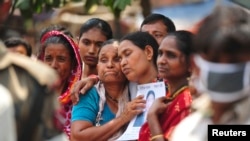NEW DELHI —
Tens of thousands of workers have returned to textile factories in Bangladesh's capital a week after the collapse of a factory compound that killed more than 420 people.
Eight days after walking off their jobs, Bangladeshi garment workers - the backbone of the country’s $20 billion textile industry - returned to work on Thursday.
Rescuers continued to pull bodies from the rubble of a factory compound that collapsed on April 24. More than 2,000 people have been rescued and some 150 others remain unaccounted for.
Even as Bangladeshis bury their dead, the vice president of Bangladesh’s Garment Manufacturers and Exporters Association, Shahidullah Azim, says that his organization is working with the building authority and taking all measures to prevent future tragedies.
"We have joint team which will inspect the suspected factories which have problems of cracks or whatever," he said. "If we receive any information [on suspected infrastructure problems], we have a team and immediately they will move and make the report."
Still, garment workers and activists say they have heard such promises before. Just six months ago, more than 100 people died in a textile factory fire in Dhaka, with many workers jumping out of windows to escape the flames.
Alonzo Suson with the Bangladesh Center for Workers' Solidarity says he is not convinced that working conditions will change in a country where most garment workers earn less than $50 a month.
He says a 16-year-old garment worker whose arm was amputated after the collapse told him she was not forced to go to work on that fateful day, but was told she would lose a week’s worth of pay if she didn’t enter the compound.
"Already pay is so low that it’s [about] survival. So yes, they [garment workers] are going to work. They know that some of the factories they are working in are unsafe, but they also need to survive, so it’s a vicious circle," he said.
Suson says Bangladesh’s garment industry needs greater transparency, more inspectors and national building codes. He says only 25 to 30 factories have unions, and most were formed in the last six months.
Activists say the responsibility also falls on global retailers and shoppers who buy clothes made in such working conditions.
Meanwhile, the owner of the collapsed compound remains in police custody in Dhaka as protesters call for the death penalty in his case.
Eight days after walking off their jobs, Bangladeshi garment workers - the backbone of the country’s $20 billion textile industry - returned to work on Thursday.
Rescuers continued to pull bodies from the rubble of a factory compound that collapsed on April 24. More than 2,000 people have been rescued and some 150 others remain unaccounted for.
Even as Bangladeshis bury their dead, the vice president of Bangladesh’s Garment Manufacturers and Exporters Association, Shahidullah Azim, says that his organization is working with the building authority and taking all measures to prevent future tragedies.
"We have joint team which will inspect the suspected factories which have problems of cracks or whatever," he said. "If we receive any information [on suspected infrastructure problems], we have a team and immediately they will move and make the report."
Still, garment workers and activists say they have heard such promises before. Just six months ago, more than 100 people died in a textile factory fire in Dhaka, with many workers jumping out of windows to escape the flames.
Alonzo Suson with the Bangladesh Center for Workers' Solidarity says he is not convinced that working conditions will change in a country where most garment workers earn less than $50 a month.
He says a 16-year-old garment worker whose arm was amputated after the collapse told him she was not forced to go to work on that fateful day, but was told she would lose a week’s worth of pay if she didn’t enter the compound.
"Already pay is so low that it’s [about] survival. So yes, they [garment workers] are going to work. They know that some of the factories they are working in are unsafe, but they also need to survive, so it’s a vicious circle," he said.
Suson says Bangladesh’s garment industry needs greater transparency, more inspectors and national building codes. He says only 25 to 30 factories have unions, and most were formed in the last six months.
Activists say the responsibility also falls on global retailers and shoppers who buy clothes made in such working conditions.
Meanwhile, the owner of the collapsed compound remains in police custody in Dhaka as protesters call for the death penalty in his case.









